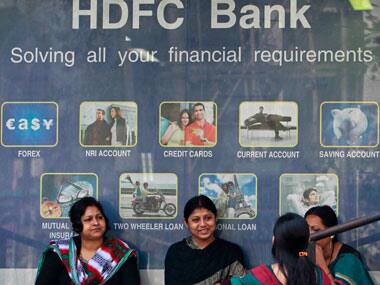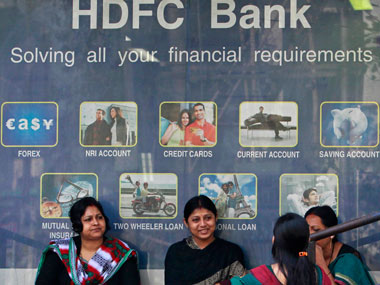Has the growth story of HDFC Bank, India’s most successful private sector bank, peaked? At around Rs 1,55,000 crore, HDFC Bank is currently India’s most valuable bank by far, 35-37 percent ahead of the State Bank of India, which is five times as big.
What this tells us is that the quality of HDFC Bank’s performance and earnings is vastly superior to that of the SBI, or even that of its biggest private sector bank, ICICI Bank, which had a market-cap similar to SBI’s.
[caption id=“attachment_75465” align=“alignleft” width=“380”]
 Has the growth story of HDFC Bank, India’s most successful private sector bank, peaked? Reuters[/caption]
Has the growth story of HDFC Bank, India’s most successful private sector bank, peaked? Reuters[/caption]
The reasons for this are simple: over the last 10 years, thanks to its superior performance, not only has HDFC Bank posted quarterly earnings growth in the range of 30-percent -plus regularly, but also grown its net worth faster than its balance-sheet - which means most of the incremental capital the bank needs has been coming from its own internally-generated profits. This is the key reason for the huge premium investors are willing to pay for a piece of the bank. The markets always reward efficient use of capital.
But here’s the takeout:
HDFC Bank’s era of outperformance may be ending. And at some point it will have to confront the issue of maintaining margins as opposed to volumes and growth. In short, it will be facing the same problems which Infosys faced where it had to bring back old warhorse NR Narayana Murthy to set things right.
Over the last two quarters, the bank has begun subtly signalling a slowdown in pace - which, if not reversed - could lead to some loss of market premium relative to its private sector peers. At current quoted prices, HDFC Bank is valued at a price-to-book value ratio of 4.29 against ICICI Bank’s 1.67. This means the market values HDFC Bank two-and-a-half times as much as the biggest private sector bank. This premium will decline.
The first clanger came in October 2013, when HDFC Bank announced its second quarter results. For the first time in nearly a decade, net profit growth fell below 30 percent to 27 percent and the loan book grew slightly slower than the banking sector as a whole. Mint newspaper quoted the bank’s Deputy Managing Director, Paresh Sukhthankar, who will probably succeed Aditya Puri as boss in 2016, as saying this was due to a curtailment of wholesale loans, which had become unattractive due to high short-term interest rates. He said: “It was a tactic to be muted in wholesale loans because when short-term loans were at double digits, we could not give loans at 11 percent to 11.50 percent and expect to maintain our margins.” Net result: the loan book grew at 16 percent, marginally below the industry average of 16.2 percent.
The second jolt came with the third quarter results in January, when net profit growth fell further to 25 percent. This time Sukhthankar explained the sub-30 percent net profit growth to Business Standard thus: “We never had a number that we wanted to stick to. Our aim has always been to grow a little faster than the system and we will continue to do so. This quarter, our profit growth was clearly boosted by tight cost control. Our asset quality also improved and that gave us some cushion in terms of lower provisioning.”
If even 25 percent growth is the result of belt-tightening and lower provisioning, one has to wonder if the super-high profit days of the bank are over?
Brokerage house Nirmal Bang has, meanwhile, flagged fresh concerns about HDFC Bank: the concentration of retail deposits in a few ultra-high net worth individuals (UNHIs). Apparently, 14 percent of HDFC Bank’s retail customers account for 71 percent of retail deposits and 53 percent of total deposits. This concentration is up from 11.8 percent of retail depositors accounting for 58 percent of retail deposits and 34.8 percent of total deposits in 2007-08.
What this means is that the bank is depending on fewer people for larger deposits - and this trend has accelerated after the Lehman crisis in 2007-08.
As Nirmal Bang says: “UNHI deposit concentration can pose a problem in unforeseen circumstances: in normal times, the deposit concentration may not pose a problem and instead prove to be profitable, but in unforeseen circumstances the sudden withdrawal of funds by this category of depositors can pose a serious challenge and, therefore, we view this as an unquantified risk.”
In fact, this kind of “unforeseen” circumstances were seen in 2008-09 in the aftermath of the global financial crisis and ICICI Bank was the first one to be impacted.
When the world heard that ICICI Bank may have lost money on exposures to US credit derivatives, big depositors suddenly started withdrawing money from ICICI Bank and shifting it to government-run banks.
Big depositors, among them Infosys Technologies (which terminated a Rs 1,000 crore deposit), withdrew thousands of crores in a few weeks, and ICICI Bank had its work cut out to calm the markets and depositors. Luckily, the US government unleashed a flood of money supply to ease the credit freeze and the global markets calmed down, helping ICICI Bank.
This is not to say the HDFC Bank deposit concentration issue is the same as that of ICICI Bank in 2008-09, but the risks need to be noted. In fact, as the Cobrapost sting operation showed, many banks, including HDFC Bank, are vulnerable to using big money from uncertain sources, and if this source evaporates, it could reduce deposits quickly.
More importantly, the markets will be watching the next few quarters of HDFC Bank results like a hawk. If the results indicate a continued sub-30 percent growth trend, it may begin rerating the stock.
The chances are HDFC Bank’s slower growth trajectory is entirely in keeping with the concept of “reversal to the mean”. No company, however great, can outperform everybody for years on end. Also, as a bank grows, maintaining the same rate of growth on a higher base cannot be sustained forever.
HDFC Bank may be on its way to becoming a more “normal” performer in the quarters and years ahead. When current boss Aditya Puri, the author of the bank’s super success, hangs up his boots sometime in late 2015, he will leave a solid, but slower growing bank.
)